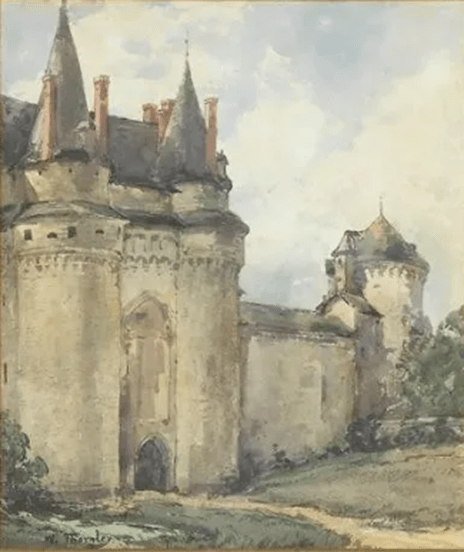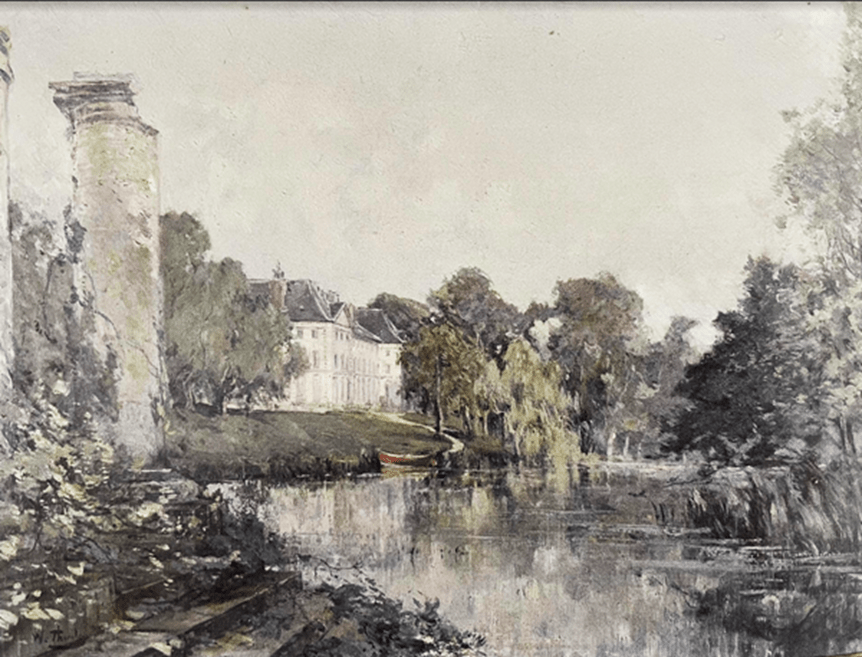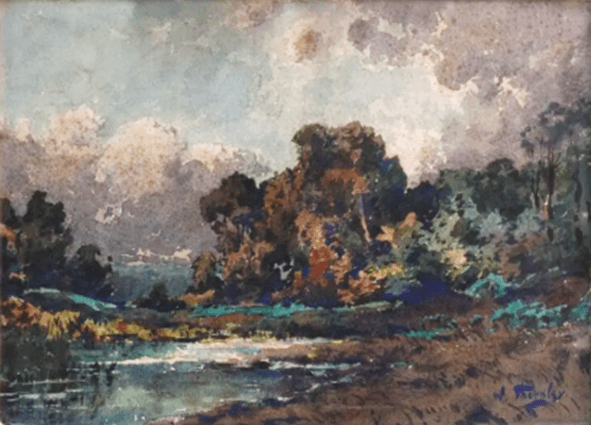La Porte fortifiée. Aquarelle (34x30cm). Après 1900. Visuel (copyright : DUPONT & Associés – Morlaix – Paris) présenté avec l’aimable autorisation de la Maison des Ventes Dupont & Associés Morlaix-Paris. #dupont.associes.encheres. (Lot 505 – Vente du 5 novembre 2024 à Saint-Martin-des-Champs – Finistère – 29600)
Cette porte fortifiée appartient au Château de Vitré (Bretagne – Ille-et-Vilaine) dont les origines (motte castrale) remontent au début du Xième siècle de notre ère. La reconstruction en pierres de l’édifice initial, par le baron de Vitré Robert 1er (1034-1072), date de la fin du Xième siècle. C’est au XIIIème siècle que le baron André III de Vitré (1200-1250) apporta au château sa forme actuelle.
William Thornley, illustre « peintre voyageur », eut de nombreuses occasions de parcourir la Bretagne (entre autres, en 1877, 1888, 1911, 1913 et 1920). C’est en 1878, qu’au Salon de Peinture et de Sculpture de Paris, il débuta officiellement sa carrière de peintre en présentant une aquarelle intitulée « La rade de Pornic » (lot 3882). Parmi les sites bretons qu’il reproduisit (aquarelles ou huiles), en dehors de Pornic qui fait partie de la Bretagne historique, figurent Dinan, Bréhat, Paimpol, Portieux, Saint-Malo, Vitré et l’Ile de Bréhat (liste non exhaustive).
Le format de la signature et le style de l’œuvre permettent de situer la réalisation de cette aquarelle après 1900 (probablement entre 1910 et 1920).

The fortified gate. Watercolor (34x30cm). After 1900. Visual (copyright: DUPONT & Associés – Morlaix – Paris) presented with the kind permission of the Auction House Dupont & Associés Morlaix-Paris. #dupont.associes.encheres
This fortified gate belongs to the Château de Vitré whose origins (castral mound) date back to the beginning of the 11th century AD. The reconstruction in stone of the initial building, by Baron Robert I of Vitré (1034-1072) dates from the end of the 11th century. It was Baron André III of Vitré (1200-1250) who gave the castle its current form. William Thornley, a « travelling painter », had many opportunities to travel around Brittany (in 1877, 1888, 1911, 1913 and 1920, among others). It was in 1878 that, at the Salon de Peinture et de Sculpture in Paris, he officially began his career as a painter by presenting a watercolour entitled « La rade de Pornic » (lot 3882). Among the Breton sites that he reproduced (watercolours or oils), apart from Pornic which is considered part of historic Brittany, are Dinan, Bréhat, Paimpol, Portieux, Saint-Malo, Vitré and the Island of Bréhat (non-exhaustive list). The format of the signature and the style of the work allow us to situate the creation of this watercolour after 1900 (probably between 1910 and 1920).



